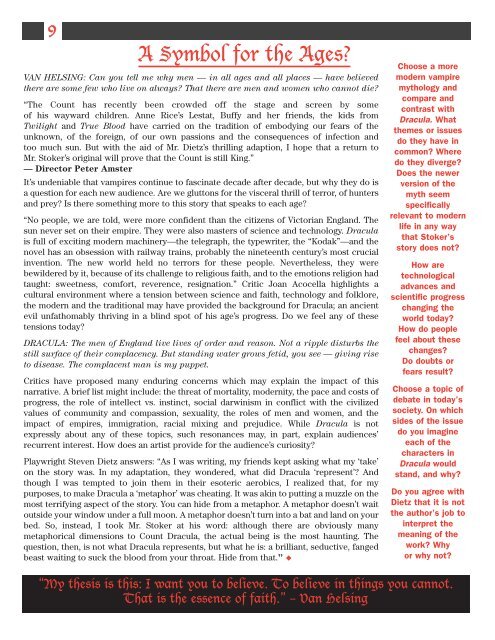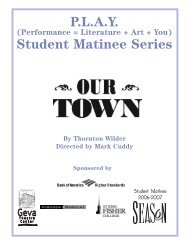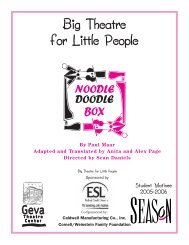Written by Steven Dietz Directed by Peter Amster - Geva Theatre
Written by Steven Dietz Directed by Peter Amster - Geva Theatre
Written by Steven Dietz Directed by Peter Amster - Geva Theatre
You also want an ePaper? Increase the reach of your titles
YUMPU automatically turns print PDFs into web optimized ePapers that Google loves.
9<br />
A Symbol for the Ages?<br />
VAN HELSING: Can you tell me why men — in all ages and all places — have believed<br />
there are some few who live on always? That there are men and women who cannot die?<br />
“The Count has recently been crowded off the stage and screen <strong>by</strong> some<br />
of his wayward children. Anne Rice’s Lestat, Buffy and her friends, the kids from<br />
Twilight and True Blood have carried on the tradition of embodying our fears of the<br />
unknown, of the foreign, of our own passions and the consequences of infection and<br />
too much sun. But with the aid of Mr. <strong>Dietz</strong>’s thrilling adaption, I hope that a return to<br />
Mr. Stoker’s original will prove that the Count is still King.”<br />
— Director <strong>Peter</strong> <strong>Amster</strong><br />
It’s undeniable that vampires continue to fascinate decade after decade, but why they do is<br />
a question for each new audience. Are we gluttons for the visceral thrill of terror, of hunters<br />
and prey? Is there something more to this story that speaks to each age?<br />
“No people, we are told, were more confident than the citizens of Victorian England. The<br />
sun never set on their empire. They were also masters of science and technology. Dracula<br />
is full of exciting modern machinery—the telegraph, the typewriter, the “Kodak”—and the<br />
novel has an obsession with railway trains, probably the nineteenth century’s most crucial<br />
invention. The new world held no terrors for these people. Nevertheless, they were<br />
bewildered <strong>by</strong> it, because of its challenge to religious faith, and to the emotions religion had<br />
taught: sweetness, comfort, reverence, resignation.” Critic Joan Acocella highlights a<br />
cultural environment where a tension between science and faith, technology and folklore,<br />
the modern and the traditional may have provided the background for Dracula; an ancient<br />
evil unfathomably thriving in a blind spot of his age’s progress. Do we feel any of these<br />
tensions today?<br />
DRACULA: The men of England live lives of order and reason. Not a ripple disturbs the<br />
still surface of their complacency. But standing water grows fetid, you see — giving rise<br />
to disease. The complacent man is my puppet.<br />
Critics have proposed many enduring concerns which may explain the impact of this<br />
narrative. A brief list might include: the threat of mortality, modernity, the pace and costs of<br />
progress, the role of intellect vs. instinct, social darwinism in conflict with the civilized<br />
values of community and compassion, sexuality, the roles of men and women, and the<br />
impact of empires, immigration, racial mixing and prejudice. While Dracula is not<br />
expressly about any of these topics, such resonances may, in part, explain audiences’<br />
recurrent interest. How does an artist provide for the audience’s curiosity?<br />
Playwright <strong>Steven</strong> <strong>Dietz</strong> answers: “As I was writing, my friends kept asking what my ‘take’<br />
on the story was. In my adaptation, they wondered, what did Dracula ‘represent’? And<br />
though I was tempted to join them in their esoteric aerobics, I realized that, for my<br />
purposes, to make Dracula a ‘metaphor’ was cheating. It was akin to putting a muzzle on the<br />
most terrifying aspect of the story. You can hide from a metaphor. A metaphor doesn’t wait<br />
outside your window under a full moon. A metaphor doesn’t turn into a bat and land on your<br />
bed. So, instead, I took Mr. Stoker at his word: although there are obviously many<br />
metaphorical dimensions to Count Dracula, the actual being is the most haunting. The<br />
question, then, is not what Dracula represents, but what he is: a brilliant, seductive, fanged<br />
beast waiting to suck the blood from your throat. Hide from that.” �<br />
Choose a more<br />
modern vampire<br />
mythology and<br />
compare and<br />
contrast with<br />
Dracula. What<br />
themes or issues<br />
do they have in<br />
common? Where<br />
do they diverge?<br />
Does the newer<br />
version of the<br />
myth seem<br />
specifically<br />
relevant to modern<br />
life in any way<br />
that Stoker’s<br />
story does not?<br />
How are<br />
technological<br />
advances and<br />
scientific progress<br />
changing the<br />
world today?<br />
How do people<br />
feel about these<br />
changes?<br />
Do doubts or<br />
fears result?<br />
Choose a topic of<br />
debate in today’s<br />
society. On which<br />
sides of the issue<br />
do you imagine<br />
each of the<br />
characters in<br />
Dracula would<br />
stand, and why?<br />
Do you agree with<br />
<strong>Dietz</strong> that it is not<br />
the author’s job to<br />
interpret the<br />
meaning of the<br />
work? Why<br />
or why not?<br />
“My thesis is this: I want you to believe. To believe in things you cannot.<br />
That is the essence of faith.” – Van Helsing





